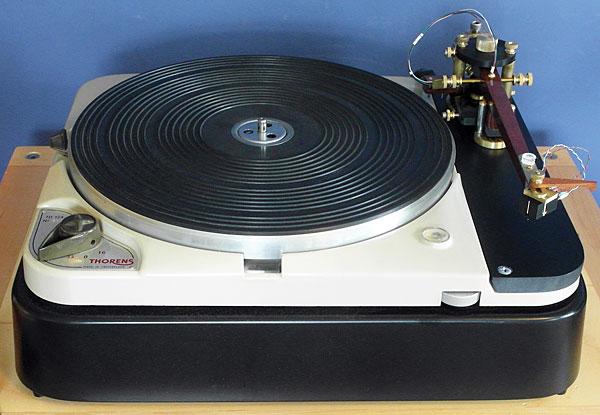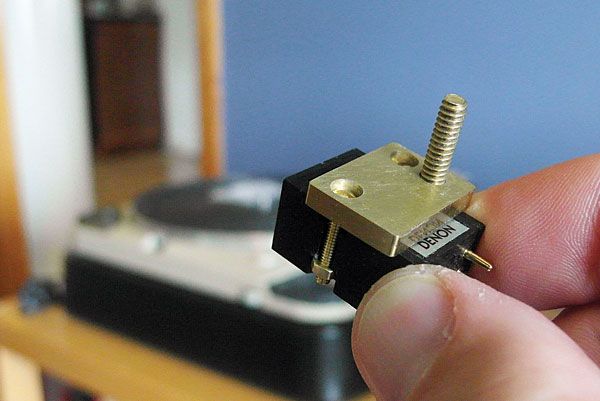| Columns Retired Columns & Blogs |
“Everything should be as simple as possible, but not simpler.”

I would go a step further: Whatever the subject, reviewing should be temporarily off-limits to people who are in a bad mood. I'm reminded of that dictum by my recent experience with a product called the String Theory Woody, a lovingly made tonearm designed and built by engineer Peter Riggle (not to be confused with Steve Diggle, lead guitarist for the excellent English band the Buzzcocks, whom I had the pleasure of seeing in their first New York show). The Woody tonearm from Pete Riggle Audio ($1600 as supplied with headshells and counterweights to suit one range of cartridge characteristics; extra parts available at extra cost, footnote 1) is a fascinating product, but its installation, in particular, should not be approached when one is feeling grouchy.
The quality that makes the Woody mildly exasperating is also one that makes it worthwhile: The Woody, which looks like a cross between the original Grado tonearm and an astrolabe, has to be the most adjustable tonearm one can buy. The point being: The installation and setup challenges posed by the Woody's adjustability are daunting in the extreme—or so they were for me: At a point very early in my time with the Woody, while wrestling with its 39 pages of instructions and illustrations and the 20-plus auxiliary parts that were packaged with the tonearm itself, I said Screw it! so loudly that I embarrassed even myself.
Yet once the user is both in the mood to avail himself of the arm's many adjustments and well versed in the need for same, it's hard not to appreciate the Woody. In fact, my most rapturously happy setup moment with the Woody came just a couple of hours after my Screw it! moment. As you surely know, the design of any pivoted tonearm takes into account a precise, set distance beyond which the stylus tip of an installed cartridge must extend past the record spindle of the associated turntable, determined by that tonearm's effective length; that amount of overhang, taken in accordance with an equally precise, set degree of cartridge offset angle, is what allows that arm and cartridge to function with as little tracing-error distortion as possible. Pete Riggle is one of the very few tonearm manufacturers with the foresight to supply with his arm a simple overhang gauge. As I discovered, by using that gauge to set overhang early in the setup process, one needs to expend very little time and effort later on. After less than a minute of dialing in the offset angle, my cartridge was perfectly aligned, my good mood restored.
Variations
The Pete Riggle Audio Woody is a unipivot tonearm, one whose single bearing point is determined not with a connective structure (in the manner of the seminal Gray 108, the Naim Aro, or any number of other such things), but with a small bit of string and a generous reliance on gravity—as in the long-standing Well Tempered Tonearm and the more sophisticated designs of Frank Schröder. The Woody's armwand is suspended from a rigid support by four short, thin strands of what Riggle describes only as "a space-age material." The structure to which these filaments are attached is in fact a knurled brass knob, turnable from above, with which the user adds antiskating by creating a twist in the bundle of threads; once the desired force has been applied—the manual recommends using an ungrooved record for this—the uncalibrated knob is locked into position with a brass setscrew.

Also in common with the Well Tempered and Schröder (footnote 2) tonearms, the Woody wand isn't just free to dangle, jerkily, but is damped with a restorative force. On the wand's underside, directly opposite the point of suspension, a short aluminum channel of rectangular cross section is rigidly attached; this is submerged within a small Delrin cup filled with a thick damping oil. A short rod, centered within and apparently integral to the cup, fits within the straight-sided channel, which is said to be lined with Teflon.
On my 9" review sample of the Woody, the square-cross-section armwand itself—which is tapered from rear to front—was indeed approximately 9" long, the working bits at both ends being made up of various metal fittings. Screwed into the rear is a round steel rod meant to accept one of the two adjustable counterweights supplied, their different masses meant to suit different cartridges. The front of the arm is fitted with a metal Headshell Adjuster Plate: a 2.25"-long piece with a single slot, this to accept the single screw that holds in place the metal headshell plate itself (to which the phono cartridge is bolted, of course). That the headshell adjuster plate is slender and the headshell spare are boons to easy cartridge alignment.
Physical support for the Woody is provided by a tonearm mount that Riggle refers to as the VTAF (Vertical Tracking Angle on the Fly), and which is available separately as an accessory for use with Rega RB300 tonearms and their derivatives. Intended to allow users to adjust tonearm height during record play, the VTAF uses an arm-support pillar machined with an extremely fine thread (footnote 3); a round, oversize nut, knurled on its outer edge and coated with Teflon on its lowermost surface; and a flanged bronze mounting sleeve for the tonearm board in which the arm pillar loosely rests.

The aforementioned damping cup isn't fastened rigidly to the arm's main support structure, but rather is attached to a pivoting lever made of brass, which Riggle refers to as the AZOF (Azimuth On the Fly). By moving that lever one way or the other, the user tilts the damping cup either toward or away from the record spindle. This, in turn, forces a change of position on the straight-sided channel that rides within the damping cup—thus rotating the wand itself and, of course, the cartridge. Once changes in azimuth have been thus effected with the AZOF lever, the user is said to have it within his power to fine-tune the armwand's balance with a long brass screw—terminated at both ends with brass thumb-nuts—that runs straight through the wand, acting not unlike a tightrope walker's pole. To achieve the desired results, the user simply grabs the Woody's left and right nuts and simultaneously twists them.
The structure that supports the damping cup extends toward the front of the arm, forming a base for both a cueing mechanism of the usual sort and a magnetic armrest, the latter of which attracts and holds a small steel staple at the bottom of the armtube (which itself resembles the hook keeper on a fly rod). Because the Woody's basic structure fits only loosely into Riggle's VTAF arm mount—and would be free to rotate if left unimpeded—the design also includes a separate VTAF Guide Assembly: a circular brass plate bolted to the armboard and fitted with a pair of posts that limit the arm structure's travel.
Other notable details include a subminiature bubble level on the Headshell Adjuster Plate; breakless, single-run wiring from cartridge clips to RCA plugs; and, on the mahogany armwand, a French-polish finish—a traditional luthiery technique in which thin coats of shellac are applied by hand with a cotton pad called a tampon. Because Pete Riggle aims for a total arm-plus-cartridge resonance of 8Hz, and because the Woody, like most commercial tonearms, will presumably be used in the field with cartridges of varying compliance, he supplies with each arm a selection of different headshells, Headshell Adjuster Plates, and other bits of hardware, made from materials of distinctly different densities (brass and aluminum being the ones most commonly used); once informed of the user's cartridge choices, Riggle then supplies a chart advising the combination of parts required for each. (Woodys are available in virtually any effective length from 9" to 16", yet variations in the length of the wooden wand have little effect on the arm's effective mass.) Riggle also supplies a packet of tiny brass shims for use in the event of insufficient clearance between the tapered armwand and the spinning record: This ensures that the pickup's rear end will still be at the correct angle when the Woody
Footnote 2: Damping in the altogether more advanced Schröder arm is accomplished not with goo but with magnetism.
Footnote 3: For owners of Rega tonearms, this is accomplished with a tubular sleeve, with threads on the inside that mate with the Rega's own threaded pillar.

“Everything should be as simple as possible, but not simpler.”